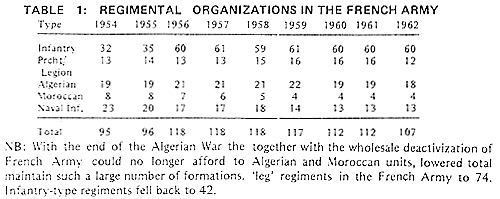
Yet, until 1956, the Algerian War remained a conflict of much the same scale as Indochina. The military forces of 120,000 troops were similar to the composition of the Expeditionary Corps in Indochina during its pre-1950 period. Even the air sortie level (a sortie is one mission by one plane), was only 1,500 (50 sorties a day) in January 1956, almost exactly the same scale of effort the French had used in Indochina during 1947-1948. At this level, the Algerian War remained the war of the professionals in the French Army. Before 1956, few draftees fought in the units on the bled (Algerian deserts).
Yet at this time events intervened to change the character of the war. The political situation in Algeria had deteriorated since 1954. By 1955, the FLN had widespread support both in Algeria, and, to some extent, France. During one week in August, for example, FLN guerrillas and terrorists had been so active that more than 2,000 people and troops were killed in terrorist incidents and ALN ambushes.
On 22 August the French had cordoned off the Moslem quarters in the Algerian cities and arrested every known FLN member or sympathizer. Only a month later the majority of deputies in the French National Assembly declared themselves to be in favor of 'the idea of Algerian nationality.'
On 18 October the National Assembly voted in favor of full implementation of the 1947 law which should have guaranteed Algerians an expansion of the franchise and a higher standard of living. In the meantime, at the United Nations, the French delegation had walked out after Algeria was put on the agenda for discussion by the General Assembly
These events put the French government on notice that its political support for continuation of the Algerian War was on the decline. Large- scale ALN activity could have had the effect of eroding this support even further. The consideration, therefore, was that military victory against the FLN would have to be forthcoming within the near future if the French were to succeed in retaining control of Algeria. This necessitated major reinforcement of the armed forces fighting in that area.
From the point of view of the French High Command, however, major reinforcement could not be had. In early 1956, after a series of successful ALN attacks, the Army managed to send ten additional battalions to Algeria along with 30 squadrons of riot police, but these forces were virtually the bottom of the barrel.
The main reason for this was the overall requirement for French armed forces. According to the NATO planning for Western Europe, France was supposed to have earmarked 14 divisions for the defense of Western Europe against any possible Soviet attack out of East Germany or Czechoslovakia. France, at first tied down in Indochina, and then in Algeira, had never been able to meet this requirement.
Even in 1955, after the end in Indochina, only five of the French divisions were anywhere near their combat strength (80%). The other nine divisions averaged only 55% strength, and in any case four of the fourteen units, including some of the best equipped ones, were already deployed in Algeria. No additional troops were available for Algeria.
Accordingly, after six weeks of deliberations, the French government ordered the mobilization of 200,000 reservists on 10 April 1956. The recalled reservists enabled the French Army to activate 25 infantry regiments, raising the total army regimental strength from 96 to 118. Mobilization and excellent staff work enabled the French to raise their force level in Algeria to almost 400,000 by July 1956. To Algeria went the 19th Infantry, 4th Mechanized, and 5th Armored Divisons along with portions of the 7th Mechanized Division.
Colonial Twilight The French War in Algeria
-
Introduction
Origins of the Algerian War
War Comes to Algiers
The Year of Mobilization
The New War Strategy
Battle of Algiers
Challe's Campaign of 1959
Jaws of Victory
Back to Campaign # 73 Table of Contents
Back to Campaign List of Issues
Back to MagWeb Master Magazine List
© Copyright 1976 by Donald S. Lowry
This article appears in MagWeb (Magazine Web) on the Internet World Wide Web. Other military history articles and gaming articles are available at http://www.magweb.com